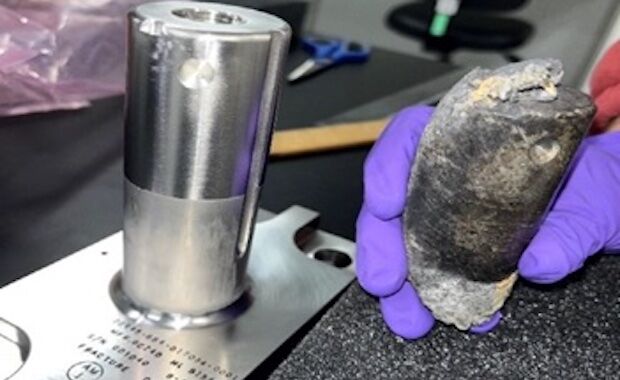Family whose roof was damaged by space debris files claims against NASA

The piece of debris that fell through Alejandro Otero’s roof (right) came from a support bracket jettisoned from the International Space Station.
The owner of a home in southwestern Florida has formally submitted a claim to NASA for damages caused by a chunk of space debris that fell through his roof in March.
The legal case is unprecedented—no one has evidently made such a claim against NASA before. How the space agency responds will set a precedent, and that may be important in a world where there is ever more activity in orbit, with space debris and vehicles increasingly making uncontrolled reentries through Earth’s atmosphere.
Alejandro Otero, owner of the Naples, Florida, home struck by the debris, was not home when part of a battery pack from the International Space Station crashed through his home on March 8. His son Daniel, 19, was home but escaped injury. NASA has confirmed the 1.6-pound object, made of the metal alloy Inconel, was part of a battery pack jettisoned from the space station in 2021.
An attorney for the Otero family, Mica Nguyen Worthy, told Ars that she has asked NASA for “in excess of $80,000” for non-insured property damage loss, business interruption damages, emotional and mental anguish damages, and the costs for assistance from third parties.
“We intentionally kept it very reasonable because we did not want it to appear to NASA that my clients are seeking a windfall,” Worthy said.
The family has not filed a lawsuit against NASA, at least not yet. Worthy said she has been having productive conversations with NASA legal representatives. She said the Otero family wants to be made whole for their losses, but also to establish a precedent for future victims. “This is truly the first legal claim that is being submitted for recovery for damages related to space debris,” Worthy said. “How NASA responds will, in my view, be foundational for how future claims are handled. This is really changing the legal landscape.”
Who, exactly, is liable for space debris?
If space debris from another country—say, a Chinese or Russian rocket upper stage—were to strike a family in the United States, the victims would be entitled to compensation under the Space Liability Convention agreed to by space powers half a century ago. Under this treaty, a launching state is “absolutely” liable to pay compensation for damage caused by its space objects on the surface of the Earth or to aircraft, and liable for damage due to its faults in space. In an international situation, NASA or some other US government agency would negotiate on the victim’s behalf for compensation.
However, in this case the debris came from the International Space Station: an old battery pack that NASA was responsible for. NASA completed a multi-year upgrade of the space station’s power system in 2020 by installing a final set of new lithium-ion batteries to replace aging nickel-hydrogen batteries that were reaching end-of-life. During a spacewalk, this battery pack was mounted on a cargo pallet launched by Japan.
Officials originally planned to place pallets of the old batteries inside a series of Japanese supply freighters for controlled, destructive reentries over the ocean. But due to a series of delays, the final cargo pallet of old batteries missed its ride back to Earth, so NASA jettisoned the batteries to make an unguided reentry. NASA incorrectly believed the batteries would completely burn up during the return through the atmosphere.

Because this case falls outside the Space Liability Convention, there is no mechanism for a US citizen to seek claims from the US government for damage from space debris. So the Otero family is making a first-ever claim under the Federal Torts Claim Act for falling space debris. This torts act allows someone to sue the US government if there has been negligence. In this case, the negligence could be that NASA miscalculated about the survival of enough debris to damage property on Earth.
NASA provided a form to the Otero family to submit a claim, which Worthy said they did at the end of May. NASA now has six months to review the claim. The space agency has several options. Legally, it could recompense the Otero family up to $25,000 for each of its claims based on the Federal Torts Claim Act (see legal code). If the agency seeks to pay full restitution, it would require approval from the US attorney general. Finally, NASA could refuse the claims or make an unacceptable settlement offer—in which case the Otero family could file a federal lawsuit in Florida.
Ars has sought comment from NASA about the claims made and will update this story when we receive one.
Source link




